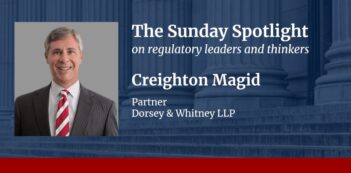
Attorney calls for consumer protection agency to increase the use of its authority to issue regulations.
Last summer, the Federal Trade Commission (FTC) initiated a sweeping rulemaking process intended to enhance consumer privacy protections and address what the agency termed “harmful commercial surveillance.”
The FTC’s decision to take this regulatory route made a reality of a recommendation offered in a 2022 law review article authored by Kurt Walters, now an attorney at the FTC. In his article, Walters proposed that the FTC revive a process of consumer protection rulemaking that scholars and policymakers have described as onerous and unpopular. He argued that those negative characterizations are a “myth” and that issuing these types of rules may be the most powerful option in the FTC’s toolkit for safeguarding consumers.
Already, the FTC has been pursuing aggressive enforcement actions related to modern consumer protection challenges: a settlement with Snapchat over its representations about the disappearing nature of the platform’s “snaps”; a lawsuit against Kochava for alleged sales of users’ health data; and an order mandating Chegg to strengthen its information security, among other actions.
But the FTC’s proposed commercial surveillance regulation is a relatively rare move for the agency. Although some have called the FTC’s recent rulemaking efforts ambitious, the FTC has defended them as part of the agency’s unambiguous authority to crack down on “unfair” or “deceptive” business practices.
In his article, Walters agrees with the FTC. He claims that the FTC should take “dearly needed action using the broad rulemaking authority that is already on the books” to protect consumers.
That authority empowers the FTC to engage in what is called a Magnuson-Moss rulemaking. Section 18 of the FTC Act sets out the special procedures that the agency must follow to invoke this discretionary consumer protection rulemaking power.
The Magnuson-Moss procedures include requirements that the FTC create a “pre-proposal” of its rule, publish and solicit public input on its proposed rule, hold informal oral hearings after the public comment period, and analyze and release the final rule. The final rule must accompany a statement describing the unfair or deceptive act that the rule addresses.
Because of the perception that these mandatory procedures are onerous, Magnuson-Moss rulemaking fell out of favor at the FTC starting in the 1980s, Walters explains. The agency started to focus instead on issuing voluntary guidance and taking steps toward deregulation.
Walters explains how each of these requirements is not significantly more burdensome than standard agency rulemaking under the Administrative Procedure Act (APA). Although the APA does not require a “pre-proposal,” for example, most agencies take this step anyway for complicated rules.
And the second Magnuson-Moss requirement tracks closely the APA’s requirement that an agency release a notice of its proposed rule, Walters contends. Even though the Magnuson-Moss version of this requirement mandates that the FTC also specify alternatives to the proposed rule, other agencies have to list such alternatives anyway to comply with requirements in an executive order and to withstand arbitrary and capricious review in the courts.
Similarly, even though Magnuson-Moss rulemaking adds extra hurdles to the fourth step—that is, agency analysis and finalization of the rule—many other agencies go above and beyond the APA’s basic requirements before releasing their final recommendations, according to Walters.
Walters claims that the only Magnuson-Moss requirement that is meaningfully more burdensome than the standard APA rulemaking process is the one calling for informal oral hearings. He explains that FTC consumer protection rulemakings require selecting a presiding officer to oversee an oral hearing and allowing participants time for rebuttals.
But this requirement is not as burdensome as it appears at first brush, Walter suggests. He notes that the presiding officer and the FTC both have the power to curb or limit the extent of this cross-examination and rebuttal process, based on how necessary that process is to the overall issue of the hearing.
And even if the process of creating consumer protection rules is somewhat more burdensome, the FTC has much to gain from jumping through the few extra hoops of Magnuson-Moss rulemaking, at least compared to other types of FTC regulatory efforts, argues Walters.
For example, although the FTC has significantly ramped up these enforcement efforts under Chair Lina Khan, enforcement can only go so far, Walters contends.
The U.S. Supreme Court in AMG Capital v. FTC made clear one limitation on the agency’s enforcement authority. There, the Court held that the FTC lacks congressional authorization to seize and distribute profits that a business made off wrongful conduct. Walters claims that this holding highlights the need for more FTC rulemaking to make up for the FTC’s inability to seek certain enforcement remedies on behalf of consumers.
Walters also cautions that FTC enforcement actions do not deter future wrongful conduct as strongly as tougher rules do, because the civil penalties for rule violations are especially steep.
And he argues that, once the FTC takes action against a business for violating an agency’s rules, the enforcement proceedings can be more efficient because the agency merely has to prove that the agency violated the rule. Proving a rule violation is often an easier task than producing evidence to establish that a business engaged in unfairness or deception under the FTC Act, Walters explains.
Although Walters claims that the Magnuson-Moss rulemaking has tremendous potential relative to regulatory alternatives, he recognizes that the FTC must act wisely to capitalize on this potential. Walters proposes, for example, that the FTC should lift certain barriers at both the oral hearing and final rule promulgation phases of Magnuson-Moss rulemaking.
Walters also recommends that the FTC invest more resources into rulemaking, including by hiring experienced rulemakers from other agencies to work within the FTC’s Office of Rulemaking. He concludes that the time is ripe for new consumer protection rulemakings, and that the option of developing rules under the FTC’s Magnuson-Moss authority presents “not just an opportunity but a responsibility.”



